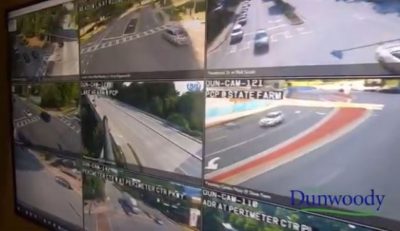Dunwoody’s new Traffic Control Center allows engineers to monitor and adjust signals to improve traffic flow.
 Dunwoody, GA – September 5, 2019 – The City of Dunwoody’s new Traffic Control Center at Dunwoody City Hall is fully operational and connected to all 60 traffic signals within the city limits. “Now we’re able to communicate with and adjust remotely all the signals in the city,” said Dunwoody Public Works Director Michael Smith. “Before this project, we could communicate with only 20 of our 60 signals.”
Dunwoody, GA – September 5, 2019 – The City of Dunwoody’s new Traffic Control Center at Dunwoody City Hall is fully operational and connected to all 60 traffic signals within the city limits. “Now we’re able to communicate with and adjust remotely all the signals in the city,” said Dunwoody Public Works Director Michael Smith. “Before this project, we could communicate with only 20 of our 60 signals.”
For a video look inside Dunwoody’s Traffic Control Center, click here.
The improved operability of the city’s signals is the result of two projects that extended the fiber-optic signal communication network and added video cameras and vehicle detection at many intersections. “The cameras are not red light cameras,” Smith added. “These are purely used to monitor traffic conditions at each intersection. We can look at the video along with the cycle of the signal in real time to troubleshoot and make timing adjustments.”
One of the projects was led by the Perimeter Community Improvement Districts (PCIDs), which contributed $370,000 and secured $1.5 million in federal congestion mitigation and air quality funding through the Atlanta Regional Commission and the Georgia Department of Transportation (GDOT). This program focused on upgrading and modernizing signals in the Perimeter area of Dunwoody, Sandy Springs and Brookhaven and connecting the existing fiber network to Dunwoody’s Traffic Control Center. Dunwoody’s project complemented the work of PCIDs by extending the signal communication network to other parts of the city at a cost of $1.1 million, with federal funding covering 80 percent of the cost.
“The PCIDs were thrilled to invest in the City of Dunwoody’s Traffic Control Center,” said PCIDs Executive Director Ann Hanlon. “This provides a new command center for monitoring and adjusting many of the intersections in the CID area, and we have already noticed a measurable difference in traffic flow. We thank the City for their partnership and their innovative approach to traffic control in our market.”
The Traffic Control Center allows engineers to monitor congestion, look for incidents and adjust signal timing to improve traffic flow.
“We can’t make traffic go away entirely, but we’re doing the best we can to get people through traffic,” said Dunwoody Traffic Signal Engineer Eli Veith. “If there’s an incident on I-285, and we know a lot of people are going to be getting off and using the surface streets, we can change the plans we’re using for the traffic signals.”
In early August, Veith took advantage of the tools in the Traffic Control Center after a Dunwoody Police Officer was dragged onto I-285 and severely injured. The incident and investigation tied up westbound traffic, and the ramp from Ashford Dunwoody Road had to be shut down.
“When we were notified about that, we were able to identify where the traffic congestion was occurring and add a lot more green time to the direction that extra cars were coming,” Veith explained. “By keeping certain directions moving and clearing people out of the area, we helped reduce the total congestion due to that incident.”
The Traffic Control Center is not manned at all hours, but traffic engineers are on-call and automatically alerted when signals malfunction. They’re able to work on the system remotely. GDOT also supports the Center with a team of engineers who work on traffic issues in Dunwoody, Brookhaven and Sandy Springs.









